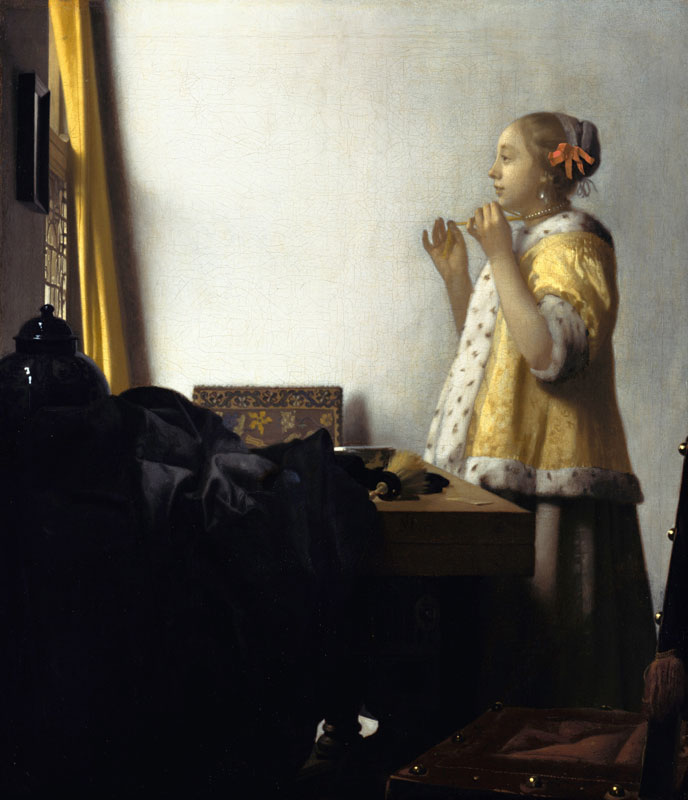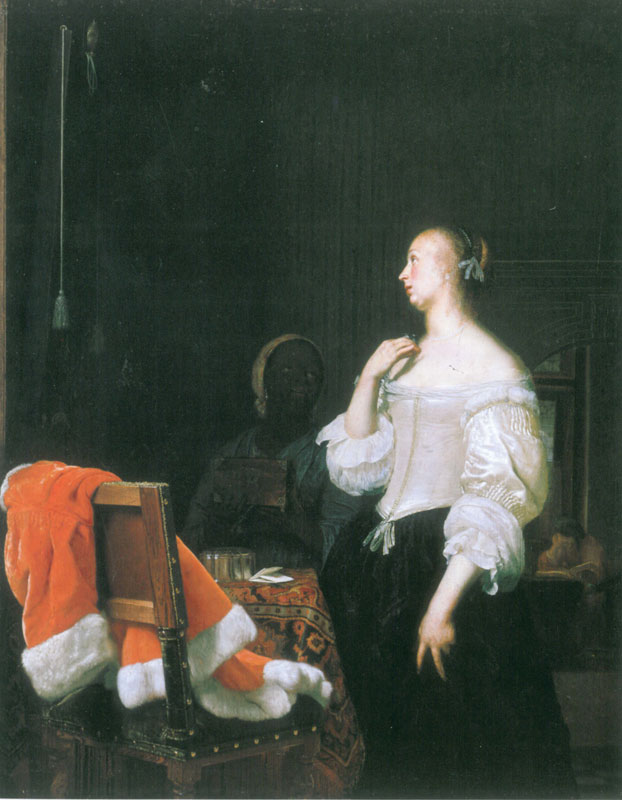This article provides a critical overview of Johannes Vermeer’s responses to Frans van Mieris’s work before focusing on a case of direct influence involving the former’s Woman with a Lute from the Metropolitan Museum of Art, New York, and the latter’s Woman Playing a Theorbo-Lute from the National Gallery of Scotland, Edinburgh, which seems to have been overlooked in the literature on Vermeer. The Delft artist’s admiration for the work of his Leiden contemporary is also visible in the former’s Guitar Player (London, Kenwood House). In contrast to Vermeer’s paintings, van Mieris’s music scene made a strong impact on contemporary artists.
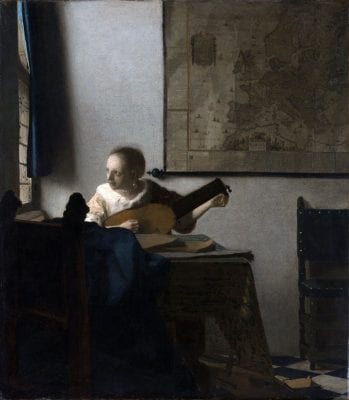
Although Dutch genre painters active in the third quarter of the seventeenth century were based in different cities in the Dutch Republic, their work bears strong similarities in style, subject matter, composition, and technique. They frequently appropriated ideas from each other’s paintings and attempted to surpass each other’s work in verisimilitude, technical prowess, and aesthetic appeal. A striking example of this vibrant artistic rivalry is Johannes Vermeer’s (1632–1675) relationship with Frans van Mieris (1635–1681). Although contact between the two artists has not been documented, they unquestionably knew each other personally—their respective residences, Delft and Leiden, were located merely twenty kilometers apart. Vermeer was three years older than van Mieris, but there is little doubt that he looked up to the latter’s social and financial status.1 The Delft artist, moreover, strongly admired his contemporary’s work. Ever since Edouard Plietzsch suggested in 1939 that some of van Mieris’s paintings served as an example to Vermeer, scholars have identified a number of connections between the Delft artist’s works and those of his Leiden colleague.2 Inspired by a conversation I had with Walter shortly before his death, this article provides a critical overview of Vermeer’s responses to van Mieris’s work. It will then focus on a case of direct influence involving Woman with a Lute (fig. 1) from the Metropolitan Museum of Art, New York, which seems to have been overlooked in the literature on Vermeer.
Although Vermeer remained a resident of Delft throughout his life, his work is inextricably linked to that of contemporary painters living elsewhere. His early history and genre paintings suggest that he studied the work of, among others, Jacob van Loo (1614–1670) from Amsterdam, Gerrit van Honthorst (1592–1656) from Utrecht, Nicolaes Maes (1634–1693) from Dordrecht, Gerard ter Borch (1617–1681) from Deventer, and Gerrit Dou (1613–1675) from Leiden. Vermeer’s admiration of Dou’s work probably led him to the latter’s star pupil, van Mieris. Around 1657 this precocious artist found a new niche in Dutch genre painting by combining his master’s delicate brushwork with the genteel interactions of ter Borch’s high-life scenes.3 The refined technique, description of textures, and illusionism in Dou’s and van Mieris’s work of the 1650s certainly strongly appealed to Vermeer. They reverberated in some of his early genre scenes of the late 1650s, including The Letter Reader (Dresden, Gemäldegalerie Alte Meister, Staatliche Kunstsammlungen), Cavalier and Young Woman (New York, Frick Collection) and The Milkmaid (Amsterdam, Rijksmuseum).4
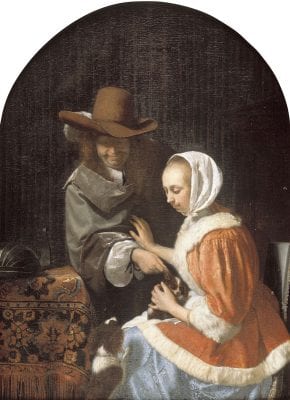
Van Mieris’s work became of greater significance to Vermeer around 1660, when the latter began adopting subjects, objects, figure poses, and compositions from the former’s paintings. The Delft artist was particularly fascinated by Man and a Woman with Two Dogs, known as “Teasing the Pet” (fig. 2) and The Oyster Meal, dated 1660 and 1661 respectively. These companion pieces first helped Vermeer shape The Glass of Wine (Berlin, Staatliche Museen, Gemäldegalerie). While the subject and figure group of this painting derives from ter Borch’s Wine Drinking Couple Served by a Page, close observation reveals that the way in which the Delft artist modeled the suitor’s cape is based on the male protagonist’s garb in van Mieris’s “Teasing the Pet.”5 Likewise, the prominent placement of the white faience jug on the corner of the carpeted table is a borrowing from The Oyster Meal.6 As van Mieris’s pendants serve as a terminus post quem to TheGlass of Wine, Vermeer’s painting should be dated to 1661–62, or to 1660 at the earliest, if we assume that the Delft artist had access to The Oyster Meal before it was completed and inscribed with a date.7 This possibility should by no means be excluded. In the mid-1660s, Eglon van der Neer (1635/36–1703) and Jacob Ochtervelt (1634–1682) also made variations of van Mieris’s Doctor’s Visit before it was finished. They presumably studied the painting in the artist’s studio in Leiden.8
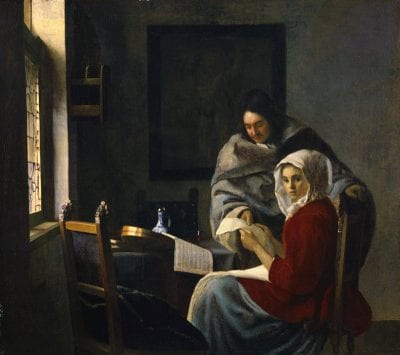
Van Mieris’s pendants also served as the principal point of departure for Vermeer’s subsequent paintings of amorous encounters. The way in which van Mieris’s suitor leans toward his lover (his right shoulder lower than his left) while grabbing the ear of a small spaniel in “Teasing the Pet” inspired Vermeer to paint a gentleman standing beside a lady clutching her music score between his fingers in Young Woman Interrupted at Her Music (fig. 3). The lute lying on the table seen from the rear in van Mieris’s picture prompted the Delft artist to paint (what looks like) a guitar in a similar position.9 The Oyster Meal, furthermore, was Vermeer’s chief source of inspiration when painting Young Woman with a Wine Glass (Braunschweig, Herzog-Anton-Ulrich-Museum). The way in which the grinning gentleman approaches a lady extending his right hand toward her is remarkably close to how van Mieris painted a male suitor offering an aphrodisiac to his young mistress in The Oyster Meal. Vermeer retained the position of the woman’s right hand in the center of the composition but substituted the oyster with a glass of wine, which van Mieris’s woman holds in her left hand. The fact that white faience jugs appear on the corner of the table in both paintings is, again, not coincidental.10 Van Mieris’s pendants help us date Young Woman with a Wine Glass to 1660 at the very earliest, but more plausibly to 1661–62.11
In addition toThe Oyster Meal, Vermeer’s Young Woman with a Wine Glass also recalls van Mieris’s Duet in terms of the orange-red brocade-trimmed dress and the position of the suitor’s head in front of the bottom right corner of the black ebony frame.12 The Duet, one of the most influential genre scenes of the third quarter of the seventeenth-century, remained an important source of inspiration for Vermeer throughout his career.13 In the first half of the 1660s, for instance, it prompted him to paint his own romantic tête-à-tête at a keyboard instrument in Lady at the Virginals with a Gentleman, “The Music Lesson” (Royal Collection, Her Majesty Elizabeth II).14 The Delft artist dramatically changed the format of the music scene but could not resist basing the spatial conception of his painting on van Mieris’s Cloth Shop and positioning a carpeted table in the right foreground.15
In the mid-1660s Vermeer painted several representations of single women engaged in different domestic activities and pastimes. In preparation for one of them, Woman with a Pearl Necklace (fig. 4), the Delft artist studied Van Mieris’s Woman before a Mirror (fig. 5), which represents an elegant young lady in a seductive low-cut satin bodice at her toilet in an opulent interior. The painting inspired Vermeer to repeat the image of a female figure in profile fiddling with a piece of jewelry while observing herself in a looking-glass. He followed his Leiden contemporary in placing the woman in front of a table, positioning a chair in the foreground serving as a repoussoir, and contrasting vertical and horizontal lines.16 However, Vermeer abandoned van Mieris’s artificial lighting and toned down the aristocratic and seductive character of the scene, instead depicting a toilet scene in a mundane domestic interior basked in natural daylight.17
Vermeer continued to appropriate ideas from van Mieris’s work in the second half of the 1660s, but to a lesser degree than in the preceding years.18 While his Lady Writing (Washington, D.C., National Gallery of Art) is foremost a thematic and compositional variation of ter Borch’s Woman Writing a Letter, it shares a number of features with van Mieris’s Woman Stringing Pearls, including the figure’s posture, the positioning of her body in relation to the table and the chair, and the emphasis on the bows in her hair.19 Likewise, the subject of an artist painting a woman dressed up as a Muse in his studio, as represented in Vermeer’s Art of Painting (Vienna, Kunsthistorisches Museum,), probably derived from a lost painting by Gabriel Metsu (1629–1667). But two early depictions of artist’s studios by van Mieris may have served as inspiration to the Delft artist as well.20 A stronger connection exists between Young Woman Standing at a Virginal (London, National Gallery) and van Mieris’s Duet. Vermeer’s music scene owes its subjects, composition, and the relationship between the woman’s head and the frame behind on the back wall to van Mieris’s painting.21 Finally, scholars have compared Vermeer’s use of a more schematic, polished technique during the end of his career to van Mieris’s shift to a more decorative, stylized manner of painting. Whether the paintings of the Leiden artist served as a direct example for his Delft colleague remains undetermined, however.22

Let us now turn our attention to Woman with a Lute (fig. 1) at the Metropolitan Museum of Art. This compelling picture represents a young female tuning her musical instrument while looking to the left through a window next to her as if responding to an outdoor noise or movement. The literature on Vermeer generally discusses the work in the context of contemporary images of single women by the artist’s own hand (the “pearl pictures”) or other painters’ representations of women with plucked string instruments.23 However, Vermeer scholars seem to have overlooked the painting’s relationship to van Mieris’s Woman Playing a Theorbo-Lute (fig. 6).24 Dated 1663, this remarkable picture was for a long time known only through a black-and-a-white photograph. It resurfaced in 1998 before being passed on to the National Gallery of Scotland, Edinburgh, in 2005.25 The Leiden artist represented a three-quarter-length figure playing a theorbo-lute and dressed in a flamboyant outfit. He placed her in an interior with a green curtain, a marble floor, and a classical pilaster. She looks sideways to read the score on the table, which creates a remarkable balance between the woman’s gaze directed to the left and the neck of the lute extending to the right. Although van Mieris’s woman tunes rather than plays the lute, her pose bears a striking resemblance to that of Vermeer’s musician. In fact, it cannot be a coincidence that the Delft artist, who appropriated a number of figure poses from van Mieris’s work in the first half of the 1660s, painted a woman playing a lute in a remarkably similar position.
A comparison between van Mieris’s and Vermeer’s paintings, however, indicates that, with the exception of the woman’s pose, the two works strongly differ. The Leiden painter created a contrived image of a seductive courtesan dressed in clothes uncharacteristic of Dutch fashion of the early 1660s and seated in an opulent interior. Vermeer painted a middle-class woman in a Dutch interior surrounded by mundane objects (with the exception of the lute itself and the map behind her, which were costly items). Whereas van Mieris placed his musician close to the picture plane against a dark background, his Delft contemporary positioned his figure at some distance from the viewer in a clearly defined room, based on linear perspective and filled with natural daylight. The former used his typically minute painting technique with defined contours and sharp highlights to create recognizable materials. Vermeer went in the opposite direction, painting fuzzy transitions and slightly schematic surfaces that fail to describe textures in detail.
Given the fact that Vermeer painted Woman with a Lute around the same time or shortly after his Leiden contemporary completed his picture, it seems the two works were part of a direct artistic rivalry.26 We may presume the Delft artist set out to surpass his contemporary by creating a work of art with the same thematic and formal starting point but that was less aristocratic and lascivious in character and more virtuoso in terms of light and space. These changes echo the way in which Vermeer altered van Mieris’s Woman before a Mirror (fig. 5) to arrive at Young Woman with a Pearl Necklace (fig. 4).
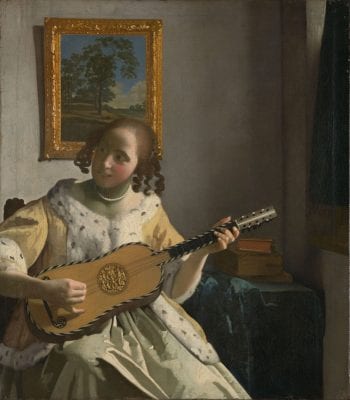
Vermeer’s admiration for van Mieris’s Woman Playing a Theorbo-Lute was not a whim. He employed the figure pose again in The Guitar Player (fig. 7) in the early 1670s. The Delft artist deviated again from the work of his Leiden contemporary by depicting a middle-class woman in contemporary clothes in a typically Dutch interior. Like the protagonist in Woman with a Lute, she turns her head sideways in response to a distraction outside the pictorial space. A few similarities between Vermeer’s Guitar Player and van Mieris’s Woman Playing a Theorbo-Lute are worth noting, however. The Delft artist positioned her close to the picture plane, as van Mieris had done. While substituting the lute with a guitar, Vermeer also represented her playing rather than tuning the instrument. The position of her right knee and the way in which the folds of the satin dress are draped around it, furthermore, are remarkably similar to what can be seen in van Mieris’s painting. Finally, the increasingly polished surfaces and textures found in Vermeer’s painting echo those in the work of his Leiden contemporary.27
If Vermeer’s aim was to surpass van Mieris’s picture, he did not convince contemporary genre painters. Neither Vermeer’s Woman with a Lute, nor The Guitar Player served as inspiration to other seventeenth-century artists.28 Van Mieris’s Woman Playing a Theorbo-Lute, by contrast, made a strong impact on several Dutch artists. Caspar Netscher (1639–1684) from The Hague painted two variations in the late 1660s to early 1670s.29 Eglon van der Neer (1634–1703), while living in Rotterdam, painted no fewer than six variations of van Mieris’s composition, all deviating in different aspects from their example.30 Woman Playing a Theorbo-Lute remained popular during the late seventeenth and early eighteenth centuries, serving as inspiration to, among others, Michiel van Musscher (1645–1705), Willem Verschuring (1665/67–1715/27), Pieter van der Werff (1665–1722), and Phillip van Dijk (1683–1753).31
Despite its initial popularity, van Mieris’s painting today lacks the fame of Vermeer’s two canvases. The exhibition Vermeer and the Masters of Genre Painting: Inspiration and Rivalry, to be held in 2017–18, will bring van Mieris’s painting and Vermeer’s Woman with a Lute together for the first time.32 This juxtaposition will give visitors a chance to compare the two works and decide for themselves whether the Delft artist succeeded in surpassing his Leiden contemporary.

